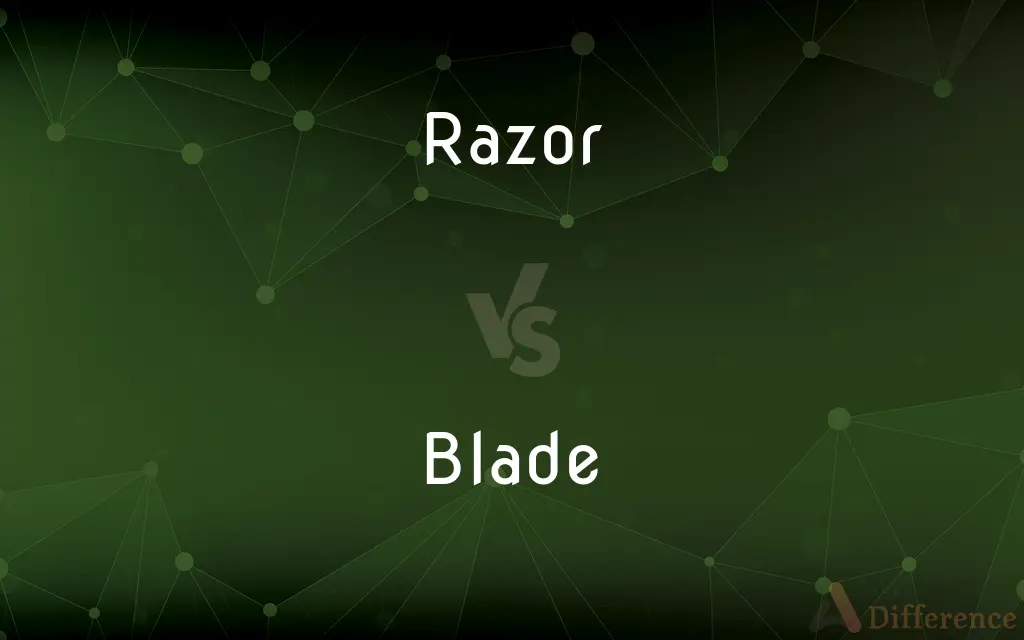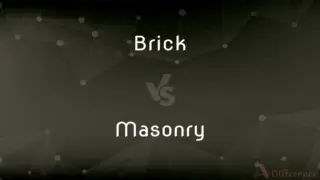Razor vs. Blade — What's the Difference?
By Urooj Arif & Fiza Rafique — Updated on April 1, 2024
A razor is a tool designed for shaving, incorporating a handle and a blade, while a blade is the cutting edge that performs the shaving.

Difference Between Razor and Blade
Table of Contents
ADVERTISEMENT
Key Differences
A razor and a blade are closely related but serve different roles in the act of shaving. The razor is the complete tool that includes a handle and a mechanism to hold the blade, which is the actual cutting part. While the razor is designed for safety, comfort, and precision in guiding the blade across the skin, the blade itself is a thin piece of metal sharpened on one or both edges, responsible for cutting the hair.
The design and material of razors have evolved over time, ranging from straight razors with a fixed blade to safety razors with replaceable blades, and electric razors that use rotating or oscillating blades. Blades, on the other hand, are specifically made from materials like stainless steel for durability, sharpness, and rust resistance. The primary focus in blade technology is on sharpness, edge retention, and minimizing irritation during shaving.
Razors are often designed with specific features to enhance the shaving experience, such as adjustable angles for the blade, multiple blades for a closer shave, and ergonomic handles for better control. Blades, however, are crafted with precision to have a specific edge geometry and coatings that reduce friction and increase comfort during the shave.
In terms of maintenance and lifespan, razors, especially those made from high-quality materials, can last for many years or even a lifetime, especially in the case of straight razors. Blades, due to their direct contact with hair and skin, have a shorter lifespan and need to be replaced regularly to maintain sharpness and hygiene.
The relationship between a razor and a blade is integral; one cannot function without the other in the context of shaving. While the razor provides the structure and safety features, the blade is the essential component that executes the action of cutting the hair. This synergy is what allows for an effective and comfortable shaving experience.
ADVERTISEMENT
Comparison Chart
Definition
A shaving tool consisting of a handle and a mechanism to hold a blade.
A thin, sharp-edged piece of metal used for cutting.
Primary Function
To provide a safe, comfortable, and precise way to guide the blade across the skin for shaving.
To cut hair by being sharp and durable.
Varieties
Straight razors, safety razors, electric razors.
Single-edge, double-edge, cartridge blades, electric razor blades.
Material & Design Focus
Handle ergonomics, blade angle, and safety features.
Sharpness, edge retention, material (usually stainless steel).
Lifespan & Maintenance
Can last for years or a lifetime, requires cleaning, and sometimes blade replacement.
Needs regular replacement due to wear and hygiene reasons.
Compare with Definitions
Razor
High-quality razors can serve as long-lasting grooming tools, with proper care.
A well-maintained straight razor can last a lifetime, offering a nod to traditional shaving methods.
Blade
Focus on material and edge technology aims to provide a close, comfortable shave with minimal irritation.
Blades with a platinum coating glide more smoothly over the skin, reducing irritation.
Razor
Often designed with features like adjustable blade angles for a more personalized shaving experience.
Adjustable safety razors allow for customization of the blade exposure, suiting different skin types.
Blade
Advances in blade technology continue to improve the efficiency and comfort of shaving.
Innovations in blade design, such as thinner edges and lubrication strips, enhance the shaving experience.
Razor
Can vary significantly in design, from traditional straight razors to modern safety and electric razors.
Electric razors offer convenience and speed, reducing the risk of cuts.
Blade
Comes in various forms, including single-edge, double-edge, and specialized blades for electric razors.
Double-edge blades offer two cutting surfaces, extending the lifespan of the shave before replacement.
Razor
A tool for shaving, incorporating a handle for grip and a mechanism to hold a blade.
The ergonomic design of modern razors ensures a comfortable and close shave.
Blade
The cutting edge in shaving tools, designed to remove hair by slicing through it at skin level.
Stainless steel blades are preferred for their sharpness and resistance to rust.
Razor
Requires maintenance such as cleaning and, for non-electric types, blade replacement.
Regular cleaning and blade replacement in safety razors ensure optimal performance.
Blade
Requires replacement after several uses to maintain sharpness and hygiene.
Replacing the blade regularly in a safety razor prevents dull shaving experiences and skin irritation.
Razor
A razor is a bladed tool primarily used in the removal of body hair through the act of shaving. Kinds of razors include straight razors, safety razors, disposable razors, and electric razors.
Blade
A blade is the portion of a tool, weapon, or machine with an edge that is designed to puncture, chop, slice or scrape surfaces or materials. Blades are typically made from materials that are harder than those they are to be used on.
Razor
A sharp-edged cutting instrument used especially for shaving or cutting hair, especially from the face or legs.
Blade
The flat cutting part of a sharpened weapon or tool.
Razor
See safety razor.
Blade
A sword.
Razor
An electric device with vibrating or rotating blades used for shaving or cutting hair close to the skin.
Blade
A swordsman.
Razor
To shave, cut, or remove with a razor or similar cutting implement
Razored off the mustache.
Razored pages from a rare book.
Blade
(Archaeology) A slender, sharp-edged flake that is at least twice as long as it is wide.
Razor
A keen-edged knife of peculiar shape, used in shaving the hair from the face or other parts of the body.
Blade
A dashing youth.
Razor
Any tool or instrument designed for shaving.
Blade
A flat thin part or section, especially one that makes contact to perform a desired action
The blade of an oar.
The blade of a hockey stick.
Razor
The sharp tusk of a wild boar.
Blade
An arm of a rotating mechanism
The blade of a propeller.
The blade of a food processor.
Razor
(philosophy) A conceptual device that allows one to shave away unlikely explanations for a phenomenon.
Occam's razor, Hanlon's razor
Blade
A long, thin, often curved piece, as of metal or rubber, used for plowing, clearing, or wiping.
Razor
(transitive) To shave with a razor.
Blade
The metal runner of an ice skate.
Razor
A keen-edged knife of peculiar shape, used in shaving the hair from the face or the head; also called a straight razor.
Blade
A wide flat bone or bony part.
Razor
A device used for shaving, having a replaceable blade with a very sharp edge; also called safety razor. Also a similar device, made of plastic, in which the blade is neither replaceable nor can be sharpened, intended to be discarded after the blade dulls - called a disposable razor.
Blade
The flat upper surface of the tongue just behind the tip.
Razor
A tusk of a wild boar.
Blade
The expanded part of a leaf or petal.
Razor
Edge tool used in shaving
Blade
The leaf of grasses or similar plants.
Razor
Shave with a razor
Blade
To skate on in-line skates.
Blade
The (typically sharp-edged) part of a knife, sword, razor, or other tool with which it cuts.
Blade
(metonymy) A sword or knife.
Blade
The flat functional end or piece of a propeller, oar, hockey stick, chisel, screwdriver, skate, etc.
Blade
The narrow leaf of a grass or cereal.
Blade
(botany) The thin, flat part of a plant leaf, attached to a stem (petiole). The lamina.
Blade
A flat bone, especially the shoulder blade.
Blade
A cut of beef from near the shoulder blade (part of the chuck).
Blade
The part of the tongue just behind the tip, used to make laminal consonants. Body parts
Blade
(archaeology) A piece of prepared, sharp-edged stone, often flint, at least twice as long as it is wide; a long flake of ground-edge stone or knapped vitreous stone.
Blade
(ultimate frisbee) A throw characterized by a tight parabolic trajectory due to a steep lateral attitude.
Blade
(sailing) The rudder, daggerboard, or centerboard of a vessel.
Blade
A bulldozer or surface-grading machine with mechanically adjustable blade that is nominally perpendicular to the forward motion of the vehicle.
Blade
(dated) A dashing young man.
Blade
Thin plate, foil.
Blade
(photography) One of a series of small plates that make up the aperture or the shutter of a camera.
Blade
The principal rafters of a roof.
Blade
(biology) The four large shell plates on the sides, and the five large ones of the middle, of the carapace of the sea turtle, which yield the best tortoise shell.
Blade
(computing) A blade server.
Blade
(climbing) knifeblade
Blade
(mathematics) An exterior product of vectors. (The product may have more than two factors. Also, a scalar counts as a 0-blade, a vector as a 1-blade; an exterior product of k vectors may be called a k-blade.)
Blade
The part of a key that is inserted into the lock.
Blade
An artificial foot used by amputee athletes, shaped like an upside-down interrogation mark.
Blade
(informal) To skate on rollerblades.
Blade
(transitive) To furnish with a blade.
Blade
To put forth or have a blade.
Blade
(transitive) To stab with a blade
Blade
To cut (a person) so as to provoke bleeding.
Blade
Properly, the leaf, or flat part of the leaf, of any plant, especially of gramineous plants. The term is sometimes applied to the spire of grasses.
The crimson dulse . . . with its waving blade.
First the blade, then ear, after that the full corn in the ear.
Blade
The cutting part of an instrument; as, the blade of a knife or a sword.
Blade
The broad part of an oar; also, one of the projecting arms of a screw propeller.
Blade
The scapula or shoulder blade.
Blade
The principal rafters of a roof.
Blade
The four large shell plates on the sides, and the five large ones of the middle, of the carapace of the sea turtle, which yield the best tortoise shell.
Blade
A sharp-witted, dashing, wild, or reckless, fellow; - a word of somewhat indefinite meaning.
He saw a turnkey in a triceFetter a troublesome blade.
Blade
The flat part of the tongue immediately behind the tip, or point.
"Lower blade" implies, of course, the lower instead of the upper surface of the tongue.
Blade
To furnish with a blade.
Blade
To put forth or have a blade.
As sweet a plant, as fair a flower, is fadedAs ever in the Muses' garden bladed.
Blade
Especially a leaf of grass or the broad portion of a leaf as distinct from the petiole
Blade
A dashing young man;
Gay young blades bragged of their amorous adventures
Blade
Something long and thin resembling a blade of grass;
A blade of lint on his suit
Blade
A cutting or thrusting weapon with a long blade
Blade
A cut of beef from the shoulder blade
Blade
A broad flat body part (as of the shoulder or tongue)
Blade
The part of the skate that slides on the ice
Blade
Flat surface that rotates and pushes against air or water
Blade
The flat part of a tool or weapon that (usually) has a cutting edge
Common Curiosities
Can any blade fit any razor?
No, blades and razors are designed to fit specific types. Always use the correct blade for your razor model.
Can you use a blade without a razor?
No, blades are designed to be used within razors for safety and effectiveness.
What is a safety razor?
A safety razor is designed to protect the skin from cuts with a protective device between the blade and the skin.
Are electric razors better than traditional razors?
It depends on personal preference; electric razors offer convenience, while traditional razors may provide a closer shave.
What materials are razor blades made from?
Most are made from stainless steel, often coated with materials like platinum for sharpness and durability.
What is the main difference between a razor and a blade?
A razor is the entire tool for shaving, while a blade is the sharp edge that cuts the hair.
How do blade coatings affect shaving?
Coatings like platinum can reduce friction, enhancing comfort and longevity of the blade.
How often should you replace your razor blade?
Blades should be replaced after every 5-7 shaves or when they begin to dull.
Why do some razors have multiple blades?
Multiple blades can provide a closer shave by cutting hairs at slightly different angles.
Why do blades become dull?
Blades can become dull from cutting hair, exposure to water, and contact with skin, which reduces their sharpness over time.
How do you clean a razor?
Rinse it under hot water after each use and periodically use soap and a brush for a deeper clean.
Are straight razors still used today?
Yes, many enthusiasts prefer straight razors for their precision and the traditional shaving experience they offer.
What is a cartridge razor?
A cartridge razor uses replaceable cartridges, which include one or more blades and sometimes lubricating strips.
Can women use the same razors as men?
Yes, while razors may be marketed differently, the fundamental design and function are suitable for anyone's shaving needs.
What's the best way to store a razor?
Store it in a dry place and upright if possible to prevent blade damage and rust.
Share Your Discovery

Previous Comparison
Sad vs. Solemn
Next Comparison
Brick vs. MasonryAuthor Spotlight
Written by
Urooj ArifUrooj is a skilled content writer at Ask Difference, known for her exceptional ability to simplify complex topics into engaging and informative content. With a passion for research and a flair for clear, concise writing, she consistently delivers articles that resonate with our diverse audience.
Co-written by
Fiza RafiqueFiza Rafique is a skilled content writer at AskDifference.com, where she meticulously refines and enhances written pieces. Drawing from her vast editorial expertise, Fiza ensures clarity, accuracy, and precision in every article. Passionate about language, she continually seeks to elevate the quality of content for readers worldwide.















































